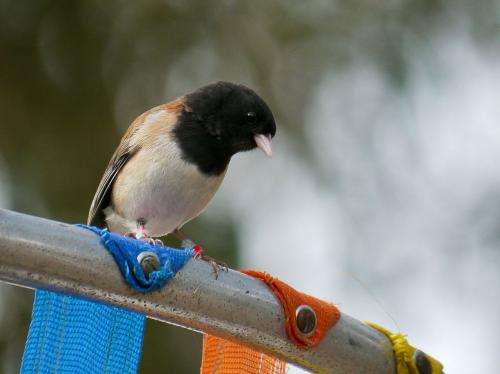Songbirds adapt to new urban environs thanks to rapid genetic evolution

(Phys.org)—Indiana University researchers have found evidence that a species of songbird that recently colonized an urban environment exhibits less stress and bolder behavior as compared to counterparts living in the forest. They conclude that adaptation to city life is connected to rapid genetic evolution of both behavior and corresponding hormonal responses.
In the study led by IU postdoctoral researcher Jonathan W. Atwell, a population of dark-eyed juncos that became established in the urban environment of San Diego County, Calif., in the early 1980s, showed persistently lower corticosterone levels when stressed and a willingness to more boldly explore novel situations when compared to a nearby population of the species living in its forested ancestral breeding range.
Previous studies have shown numerous behavioral differences between ancestral wildland animal populations and urban animal populations like the San Diego juncos, from loss of migratory behavior and earlier onset of reproduction to altered plumage ornamentation, and a willingness to more quickly approach novel objects or allow people to approach very close. But most of the time, it is not clear whether observed differences are simply behavioral and physiological adjustments individuals make in response to the new environment, or whether such differences are the result of something deeper: genetic changes.
In Atwell's study, young juveniles taken from both San Diego and the ancestral range 50 miles away were captured and then raised in an indoor aviary at IU to test the degree to which "nature versus nurture" was responsible for the behavioral and hormonal differences observed in the field.

In the aviary "common garden" study, native birds from both populations were raised under identical conditions for more than eight months. Nevertheless, just as in the field studies, the San Diego juncos explored faster and more extensively, and had lower stress-induced levels of the hormone corticosterone. Further, within each population, individuals with lower corticosterone levels were bolder in exploration tests, indicating that exploratory boldness behavior and stress hormones were closely linked.
"We think increased boldness and lower corticosterone evolved in concert during colonization, which points to the hypothalamic-pituitary-adrenal axis as a critical integrating hormonal mechanism associated with adapting to urban life," Atwell said.
The hypothalamic-pituitary-adrenal axis, or HPA axis, is a complex network of interactions between the adrenal, hypothalamus and pituitary glands that controls stress reactions and regulates digestion, the immune systems, sexuality, mood and energy usage. In humans it is associated with the neurobiology of disorders and illnesses such as bipolar disorder, alcoholism, anxiety disorder and post-traumatic stress disorder.
Given that the urban colonist juncos appear to have genes for bolder behavior and lower corticosterone levels compared to their forest counterparts, Atwell suggests that further research will establish even more clearly the association between urban adaption and HPA responses. Specifically, the group is interested in exploring and sequencing different regions of the dopamine receptor gene Drd4, which has been linked to boldness and shyness behavior in other animals.
"We're suggesting at this point that we have correlated evolution along lines of least resistance evidenced by a persistent relationship between an integrated pattern of adaptive divergence for a behavioral trait and the hormonal mechanism—the HPA axis—that underlies this divergence," he said.
While behavior and hormone levels evolved together, the scientists noted in the research published recently in Behavioral Ecology that there was no single optimum balance of hormone and behavioral strategy that was best—different behavioral and physiological strategies seem to work for different individuals and populations—so variation in these traits is maintained.
"Now we need to conduct additional studies of neuroendocrine and genetic mechanisms linking hormonal and behavioral traits to determine the evolutionary significance of these associations," Atwell added.
"Boldness behavior and stress physiology in a novel urban environment suggest rapid correlated evolutionary adaptation" was co-authored by Danielle J. Whittaker of Michigan State University; Earlham College graduate Samuel Campbell-Nelson; then IU undergraduate Kyle W. Robertson; Goncalo C. Cardoso of the Universidade do Porto, Portugal; and IU Distinguished Professor Ellen D. Ketterson. Whittaker is a former postdoctoral researcher in the Ketterson research group, which is in the IU College of Arts and Sciences' Department of Biology.
Journal information: Behavioral Ecology
Provided by Indiana University
















